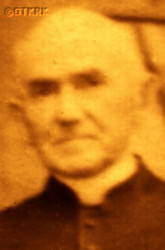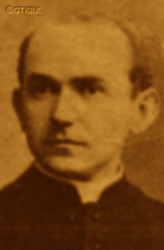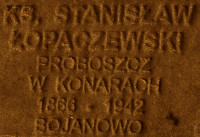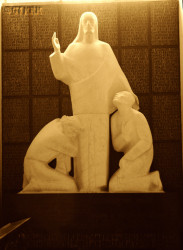Roman Catholic
St Sigismund parish
05-507 Słomczyn
85 Wiślana Str.
Konstancin deanery
Warsaw archdiocese, Poland
full list:
displayClick to display full list

searchClick to search full list by categories
wyświetlKliknij by wyświetlić pełną listę po polsku

szukajKliknij by przeszukać listę wg kategorii po polsku

Martyrology of the clergy — Poland
XX century (1914 – 1989)
personal data
surname
ŁOPACZEWSKI
forename(s)
Stanislav Kostka (pl. Stanisław Kostka)
function
diocesan priest
creed
Latin (Roman Catholic) Church RCmore on
en.wikipedia.org
[access: 2014.09.21]
diocese / province
Gniezno and Poznań archdiocese (aeque principaliter)more on
www.archpoznan.pl
[access: 2012.11.23]
date and place
of death
26.01.1942

NL Schmückertconcentration camp for nuns
today: Bojanowo, Bojanowo gm., Rawicz pov., Greater Poland voiv., Poland
more on
pl.wikipedia.org
[access: 2025.08.19]
details of death
During his ministry in Lechlin, fell foul of the Prussian authorities in the Germ. Kreis Wongrowitz (Eng. Wągrowiec County), in Prussian part of partitioned Poland, i.e. the Germ. Provinz Posen (Eng. Province Poznań), as a defender of Polishness, agitating for Polish candidates during election meetings, for which the police did not allow, and from the pulpit, before elections to the Germ. Preußischer Landtag (Eng. Prussian National Parliament) — elections took place in 1989 and 1903 — and to the Germ. Reichstag (Eng. Reich Parliament) of the German Empire — elections took place in 1989 and 1903.
In 1901, the Germ. landrat (Eng. county administrator) of Wągrowiec accused him of disregarding the anniversary of the birth of the German emperor by not allowing children to miss the preparatory classes for confession that was conducting on that day.
After German and Russian invasion of Poland in 09.1939 and start of the World War II, after start of German occupation, arrested by the Germans on 07.10.1941, as part of the action to eliminate the Polish Catholic clergy in the Germ. Reichsgau Wartheland (Eng. Wartheland Reich District) province, established in the occupied Greater Poland region.
Jailed in KL Posen (Fort VII) concentration camp.
Finally transported to NL Schmückert concentration camp, mainly for the nuns and older religious, where perished.
cause of death
extermination
perpetrators
Germans
sites and events
NL SchmückertClick to display the description, KL PosenClick to display the description, 06.10.1941 arrests (Warthegau)Click to display the description, Reichsgau WarthelandClick to display the description, Ribbentrop‐MolotovClick to display the description, Pius XI's encyclicalsClick to display the description
date and place
of birth
26.10.1866

Kórniktoday: Kórnik gm., Poznań pov., Greater Poland voiv., Poland
more on
en.wikipedia.org
[access: 2021.07.15]
parents
ŁOPACZEWSKI Casimir
🞲 ?, ? — 🕆 ?, ?

RALAJEWSKA Catherine
🞲 ?, ? — 🕆 ?, ?
presbyter (holy orders)
ordination
16.12.1894

Gnieznotoday: Gniezno urban gm., Gniezno pov., Greater Poland voiv., Poland
more on
en.wikipedia.org
[access: 2021.12.18]
positions held
1916 – 1941
parish priest — Konarytoday: Miejska Górka gm., Rawicz pov., Greater Poland voiv., Poland
more on
en.wikipedia.org
[access: 2021.12.19] ⋄ St Michael the Archangel RC parish ⋄ Jutrosintoday: Jutrosin gm., Rawicz pov., Greater Poland voiv., Poland
more on
en.wikipedia.org
[access: 2021.12.19] RC deanery
1909 – 1916
parish priest — Potulicetoday: Wągrowiec gm., Wągrowiec pov., Greater Poland voiv., Poland
more on
en.wikipedia.org
[access: 2021.07.18] ⋄ St Catherine the Virgin and Martyr RC parish ⋄ Rogoźnotoday: Rogoźno gm., Oborniki pov., Greater Poland voiv., Poland
more on
en.wikipedia.org
[access: 2021.07.18] RC deanery
1908 – 1909
administrator — Potulicetoday: Wągrowiec gm., Wągrowiec pov., Greater Poland voiv., Poland
more on
en.wikipedia.org
[access: 2021.07.18] ⋄ St Catherine the Virgin and Martyr RC parish ⋄ Rogoźnotoday: Rogoźno gm., Oborniki pov., Greater Poland voiv., Poland
more on
en.wikipedia.org
[access: 2021.07.18] RC deanery
1903 – 1908
administrator — Skokitoday: Skoki gm., Wągrowiec pov., Greater Poland voiv., Poland
more on
en.wikipedia.org
[access: 2021.07.18] ⋄ St Nicholas the Bishop and Confessor RC parish ⋄ Rogoźnotoday: Rogoźno gm., Oborniki pov., Greater Poland voiv., Poland
more on
en.wikipedia.org
[access: 2021.07.18] RC deanery
1897 – 1903
administrator — Lechlintoday: Skoki gm., Wągrowiec pov., Greater Poland voiv., Poland
more on
en.wikipedia.org
[access: 2021.07.18] ⋄ St Stanislav the Bishop and Martyr RC parish ⋄ Rogoźnotoday: Rogoźno gm., Oborniki pov., Greater Poland voiv., Poland
more on
en.wikipedia.org
[access: 2021.07.18] RC deanery
1894 – 1897
vicar — Lechlintoday: Skoki gm., Wągrowiec pov., Greater Poland voiv., Poland
more on
en.wikipedia.org
[access: 2021.07.18] ⋄ St Stanislav the Bishop and Martyr RC parish ⋄ Rogoźnotoday: Rogoźno gm., Oborniki pov., Greater Poland voiv., Poland
more on
en.wikipedia.org
[access: 2021.07.18] RC deanery
till 1894
student — Gnieznotoday: Gniezno urban gm., Gniezno pov., Greater Poland voiv., Poland
more on
en.wikipedia.org
[access: 2021.12.18] ⋄ philosophy and theology, Archbishop's Practical Theological Seminary (Lat. Seminarium Clericorum Practicum)
from 1891
student — Poznańtoday: Poznań city pov., Greater Poland voiv., Poland
more on
en.wikipedia.org
[access: 2021.07.18] ⋄ philosophy and theology, Archbishop's Theological Seminary (Collegium Leoninum)
1890 – 1891
student — Wrocławtoday: Wrocław city pov., Lower Silesia voiv., Poland
more on
en.wikipedia.org
[access: 2021.04.02] ⋄ philosophy and theology, Department of Catholic Theology, University of Wrocław [i.e. University of Wrocław (since 1945) / Frederic Wilhelm University of Silesia (1911‐1945) / Royal University i.e. Breslau Academy (1816‐1911)]
1890
student — Wrocławtoday: Wrocław city pov., Lower Silesia voiv., Poland
more on
en.wikipedia.org
[access: 2021.04.02] ⋄ medicine, University of Wrocław [i.e. University of Wrocław (since 1945) / Frederic Wilhelm University of Silesia (1911‐1945) / Royal University i.e. Breslau Academy (1816‐1911)]
1908 – 1939
membership — Poznańtoday: Poznań city pov., Greater Poland voiv., Poland
more on
en.wikipedia.org
[access: 2021.07.18] ⋄ Friends of Sciences Society
others related
in death
DERKACZEWSKAClick to display biography Stanislava (Sr Raphaella of the Holy Face), DWULECKAClick to display biography Mary (Sr Fabiola), GRYGIERClick to display biography Anne (Sr Wunibalda), GRZANKAClick to display biography Francesca (Sr Romualda), KĄKOLEWSKAClick to display biography Wanda (Sr Veronica), LEWICKAClick to display biography Claire (Sr Cordelia), MULKOWSKAClick to display biography Josefa (Sr Vestina), NIEDŹWIEDZIŃSKIClick to display biography Ignatius, OSIŃSKAClick to display biography Leocadia (Sr Radegundis), SZKUDLAREKClick to display biography Helen (Sr Hermana), BŁOCIŃSKAClick to display biography Anne (Sr Iucunda), CHWOŁKAClick to display biography Hedwig (Sr Bonifacia), FIEREKClick to display biography Francesca (Sr Potamia), GRZECHOWSKAClick to display biography Mary (Sr Sapientia), KACZMAREKClick to display biography Elisabeth (Sr Rita), KŁECZEKClick to display biography (Sr Benita), ŁUCZAKClick to display biography Marianne (Sr Siriana), PIOTRZKOWSKAClick to display biography Pauline (Sr Anacleta), SIWECKAClick to display biography Regina Stephanie (Sr Angela), TUŻYNAClick to display biography Constantina (Sr Rusticula), WANIOREKClick to display biography Theodosia (Sr Flaviana), WOJCIECHOWSKAClick to display biography Theophilusa (Sr Reinharda)
sites and events
descriptions
NL Schmückert: German concentration camp Germ. Nonnenlager (Eng. camp for nuns), set up in Bojanowo (from 1943 formally known as Schmückert by the Germans, today Rawicz county), mainly for Polish nuns. Organized by the Germans in the province of Germ. Warthegau (Eng. Warta country), after the liquidation in early 1941 of c. 248 Catholic religious houses and institutions run by the Church, 30 of which were transferred directly to the German National Socialist Party NSDAP, and the rest were administered by the Germ. Gauselbstverwaltung (Eng. Self–Government of the Region–Gau) GSV state institution. Therefore, initially formally called as Germ. Gauarbeitsanstalt Schmückert (Eng. Schmückert Gau employment office). On 25.02.1941 first group of 56 nuns was brought in. At the end of 1941 there were 293 prisoners held. On 11.12.1941 Germans brought in c. 40 old and sick priests, transported from KL Posen concentration camp. Altogether in 1941‐1945 615 nuns from 27 congregations were held captive in the camp. (more on: pl.wikipedia.orgClick to attempt to display webpage
[access: 2013.08.17], www.niedziela.plClick to attempt to display webpage
[access: 2019.04.16])
KL Posen: German Posen — Fort VII — camp founded in c. 10.10.1939 in Poznań till mid of 11.1939 operated formally as Germ. Konzentrationslager (Eng. concentration camp) KL Posen, and this term is used throughout the White Book, also later periods. It was first such a concentration camp set up by the Germans on Polish territory — in case of Greater Poland (Wielkopolska) directly incorporated into German Reich. In 10.1939 in KL Posen for the first time Germans used gas to murder civilian population, in particular patients of local psychiatric hospitals. From 11.1939 the camp operated as German political police Gestapo prison and transit camp (Germ. Übergangslager), prior to sending off to concentration camps, such as KL Dachau or KL Auschwitz. In 28.05.1941 the camp was rebranded as police jail and slave labour corrective camp (Germ. Arbeitserziehungslager). At its peak up to 7‐9 executions were carried in the camp per day, there were mass hangings of the prisoners and some of them were led out to be murdered elsewhere, outside of the camp. Altogether in KL Posen Germans exterminated approx. 20,000 inhabitants of Greater Poland (Wielkopolska) region, including many representatives of Polish intelligentsia, patients and staff of psychiatric hospitals and dozen or so Polish priests. Hundreds of priests were held there temporarily prior to transport to other concentration camps, mainly KL Dachau. From 03.1943 the camp had been transformed into an industrial complex (from 25.04.1944 — Telefunken factory manufacturing radios for submarines and aircrafts). (more on: www.wmn.poznan.plClick to attempt to display webpage
[access: 2019.02.02], en.wikipedia.orgClick to attempt to display webpage
[access: 2013.12.27])
06.10.1941 arrests (Warthegau): On 13.09.1941 Germ. Gauleiter (Eng. regional leader) of German province Germ. Reichsgau Wartheland (Eng. Wartheland Reich district), in German‐occupied Greater Poland (where German standard law was in force), Artur Greiser, implementing „Ohne Gott, ohne Religion, ohne Priesters und Sakramenten” — „without God, without religion, without priest and sacrament” — policy issued a decree formally dissolving Catholic Church and forming in its place a Roman Catholic German National Church in Germ. Warthegau, an organization subject to a German private law. The ordinance was issued backdated to 01.09.1939, i.e. the date of the German invasion of Poland, which sanctioned the later robbery of the property of the Catholic Church acting for the benefit of the Polish population by the Germans. All the contacts with Vatican were forbidden. All the religion congregations were also dissolved. Soon after, on 06‐07.10.1941, mass arrests of Polish Catholic priests took place — c. 352 were detained. All were herded into DL Konstantinow in Konstantynów or IL Lond in Ląd on Warta river transit camps or KL Posen concentration camp (in this case, the detainees were first registered, photographed and examined in the infamous Poznań headquarters of the German political police, the Gestapo, in the former Soldier's House). On 30.10.1941 most of them were transported to KL Dachau concentration camp.
Reichsgau Wartheland: After the Polish defeat in the 09.1939 campaign, which was the result of the Ribbentrop‐Molotov Pact and constituted the first stage of World War II, and the beginning of German occupation in part of Poland (in the other, eastern part of Poland, the Russian occupation began), the Germans divided the occupied Polish territory into five main regions (and a few smaller). The largest one was transformed into Germ. Generalgouvernement (Eng. General Governorate), intended exclusively for Poles and Jews and constituting part of the so‐called Germ. Großdeutschland (Eng. Greater Germany). Two were added to existing German provinces. From two other separate new provinces were created. Greater Poland region was one of them, incorporated into Germany on 08.10.1939, by decree of the German leader Adolf Hitler (formally came into force on 26.10.1939), and on 24.01.1940 transformed into the Germ. Reichsgau Wartheland province, in which the law of the German state was to apply. The main axis of the policy of the new province, the territory of which the Germans recognized as the Germ. „Ursprünglich Deutsche” (Eng. „natively German”), despite the fact that 90% of its inhabitants were Poles, was Germ. „Entpolonisierung” (Eng. „Depolonisation”), i.e. forced Germanization. C. 100,000 Poles were murdered as part of the Germ. „Intelligenzaktion”, i.e. extermination of Polish intelligentsia and ruling classes. C. 630,000 were forcibly resettled to the Germ. Generalgouvernement, and their place taken by the Germans brought from other areas occupied by Germany (e.g. the Baltic countries, Bessarabia, Bukovina, etc.). Poles were forced to sign the German nationality list, the Germ. Deutsche Volksliste DVL. As part of the policy of „Ohne Gott, ohne Religion, ohne Priesters und Sakramenten” (Eng. „No God, no religion, no priest or sacrament”) most Catholic priests were arrested and sent to concentration camps. All schools teaching in Polish, Polish libraries, theaters and museums were closed. Polish landed estates confiscated. To further reduce the number of the Polish population, Poles were sent to forced labor deep inside Germany, and the legal age of marriage for Poles was increased (25 for women, 28 for men). The German state office, Germ. Rasse‐ und Siedlungshauptamt (Eng. Main Office of Race and Settlement) RuSHA, under the majesty of German law, abducted several thousand children who met specific racial criteria from Polish families and subjected them to forced Germanization, handing them over to German families. After the end of hostilities of World War II, the overseer of this province, the Germ. Reichsstatthalter (Eng. Reich Governor) and the Germ. Gauleiter (Eng. district head) of the German National Socialist Party, Arthur Karl Greiser, was executed. (more on: en.wikipedia.orgClick to attempt to display webpage
[access: 2024.06.21])
Ribbentrop‐Molotov: Genocidal Russian‐German alliance pact between Russian leader Joseph Stalin and German leader Adolf Hitler signed on 23.08.1939 in Moscow by respective foreign ministers, Mr. Vyacheslav Molotov for Russia and Joachim von Ribbentrop for Germany. The pact sanctioned and was the direct cause of joint Russian and German invasion of Poland and the outbreak of the World War II in 09.1939. In a political sense, the pact was an attempt to restore the status quo ante before 1914, with one exception, namely the „commercial” exchange of the so‐called „Kingdom of Poland”, which in 1914 was part of the Russian Empire, fore Eastern Galicia (today's western Ukraine), in 1914 belonging to the Austro‐Hungarian Empire. Galicia, including Lviv, was to be taken over by the Russians, the „Kingdom of Poland” — under the name of the General Governorate — Germany. The resultant „war was one of the greatest calamities and dramas of humanity in history, for two atheistic and anti‐Christian ideologies — national and international socialism — rejected God and His fifth Decalogue commandment: Thou shall not kill!” (Abp Stanislav Gądecki, 01.09.2019). The decisions taken — backed up by the betrayal of the formal allies of Poland, France and Germany, which on 12.09.1939, at a joint conference in Abbeville, decided not to provide aid to attacked Poland and not to take military action against Germany (a clear breach of treaty obligations with Poland) — were on 28.09.1939 slightly altered and made more precise when a treaty on „German‐Russian boundaries and friendship” was agreed by the same murderous signatories. One of its findings was establishment of spheres of influence in Central and Eastern Europe and in consequence IV partition of Poland. In one of its secret annexes agreed, that: „the Signatories will not tolerate on its respective territories any Polish propaganda that affects the territory of the other Side. On their respective territories they will suppress all such propaganda and inform each other of the measures taken to accomplish it”. The agreements resulted in a series of meeting between two genocidal organization representing both sides — German Gestapo and Russian NKVD when coordination of efforts to exterminate Polish intelligentsia and Polish leading classes (in Germany called «Intelligenzaktion», in Russia took the form of Katyń massacres) where discussed. Resulted in deaths of hundreds of thousands of Polish intelligentsia, including thousands of priests presented here, and tens of millions of ordinary people,. The results of this Russian‐German pact lasted till 1989 and are still in evidence even today. (more on: en.wikipedia.orgClick to attempt to display webpage
[access: 2015.09.30])
Pius XI's encyclicals: Facing the creation of two totalitarian systems in Europe, which seemed to compete with each other, though there were more similarities than contradictions between them, Pope Pius XI issued in 03.1937 (within 5 days) two encyclicals. In the „Mit brennender Sorge” (Eng. „With Burning Concern”) published on 14.03.1938, condemned the national socialism prevailing in Germany. The Pope wrote: „Whoever, following the old Germanic‐pre‐Christian beliefs, puts various impersonal fate in the place of a personal God, denies the wisdom of God and Providence […], whoever exalts earthly values: race or nation, or state, or state system, representatives of state power or other fundamental values of human society, […] and makes them the highest standard of all values, including religious ones, and idolizes them, this one […] is far from true faith in God and from a worldview corresponding to such faith”. On 19.03.1937, published „Divini Redemptoris” (Eng. „Divine Redeemer”), in which criticized Russian communism, dialectical materialism and the class struggle theory. The Pope wrote: „Communism deprives man of freedom, and therefore the spiritual basis of all life norms. It deprives the human person of all his dignity and any moral support with which he could resist the onslaught of blind passions […] This is the new gospel that Bolshevik and godless communism preaches as a message of salvation and redemption of humanity”… Pius XI demanded that the established human law be subjected to the natural law of God , recommended the implementation of the ideal of a Christian state and society, and called on Catholics to resist. Two years later, National Socialist Germany and Communist Russia came together and started World War II. (more on: www.vatican.vaClick to attempt to display webpage
[access: 2023.05.28], www.vatican.vaClick to attempt to display webpage
[access: 2023.05.28])
sources
personal:
www.wtg-gniazdo.orgClick to attempt to display webpage
[access: 2012.11.23]
original images:
www.wbc.poznan.plClick to attempt to display webpage
[access: 2013.08.10]
LETTER to CUSTODIAN/ADMINISTRATOR
If you have an Email client on your communicator/computer — such as Mozilla Thunderbird, Windows Mail or Microsoft Outlook, described at WikipediaPatrz:
en.wikipedia.org, among others — try the link below, please:
LETTER to CUSTODIAN/ADMINISTRATORClick and try to call your own Email client
If however you do not run such a client or the above link is not active please send an email to the Custodian/Administrator using your account — in your customary email/correspondence engine — at the following address:

giving the following as the subject:
MARTYROLOGY: ŁOPACZEWSKI Stanislav Kostka
To return to the biography press below:
 Click to return to biography
Click to return to biography














